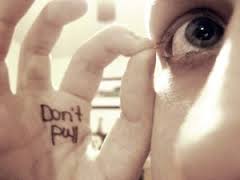Skin Picking and/or Hair Pulling Disorder
If you have a skin picking and/or hair pulling disorder, you tend to pluck, pull and pick at your nails, hair and skin. These behaviors can cause severe pain, if practiced excessively. The Diagnostic and Statistical Manual of Mental Disorders recently added skin picking and/or hair pulling disorders to the proposed future revision of the manual.
These disorders may not be very well known, but studies suggest that they have been affecting people for centuries. Treatment generally consists of a combination of medication and therapy.
Skin Picking Disorder
Chronic skin picking (CSP) is a condition that is poorly understood, but can easily cause a global epidemic. If you suffer from this disorder, you persistently scratch, touch, pick at, rub or dig into your dermis (skin), mostly in order to remove or clean minor imperfections or irregularities that you perceive as abnormal. This constant irritation to the skin can result in discoloration and even scarring. Chronic skin picking can eventually lead to severe skin damage and/or visible disfigurement. This condition can occur as a symptom of a different condition or disorder or it can present independently.
Diagnosis:

Hair pulling disorder can leave you with bald patches that can be hard to cover up.
Different dermatological disorders such as body dysmorphic disorder, substance abuse disorders, autoimmune inflammatory diseases, obsessive compulsive disorder, psychosis and developmental disorders such as autism can give rise to symptoms that include skin picking. Therefore, one of the most essential steps prior to the creation of an effective treatment plan is determining whether chronic skin picking is occurring independently, or as a symptom of another underlying cause or condition.
Chronic skin picking disorder is classified under body focused repetitive behaviors. These behaviors can result in serious damage or harm to your overall health and appearance.
Common body focused repetitive behaviors include trichotillomania, a condition that causes chronic pulling of your hair until it breaks off, excessive nail biting and habitual biting of your inner cheeks.
Studies have shown that chronic skin picking is a common condition that can occur when you are extremely afraid, bored, anxious and/or even excited. If you have this condition, you may even derive some pleasure or relief from picking your skin. In addition, you may spend hours and picking at your skin. This persistent behavior can interfere with your personal and occupational life and damage your relationships.
Compulsive Hair Pulling (Trichotillomania)
Trichotillomania is a condition that causes you to persistently pull your hair out you’re your scalp, eyebrows, beard, eyelashes, public areas, legs, underarms and various other parts of your body. This repeated hair pulling can eventually result in prominent and visible bald patches that appear unsightly. If you have a mild case of compulsive hair pulling it can be effectively treated by focusing on stopping the behavior, but if you suffer from severe compulsive hair pulling, you may not be able to focus on anything other than pulling your hair.
Treatments:
A number of treatment options are available for treating these conditions. A combination of cognitive behavioral therapy (CBT) and pharmacological therapies (medications) have shown some success.
- Cognitive Behavioral Therapy – Therapists who treat skin and/or hair picking disorders with cognitive behavioral therapy (CBT) are called habit reversal training therapists. These therapists help you recognize the times of the day and the emotions you feel while indulging in these behaviors. They also help you understand underlying factors that promote these behaviors. This type of therapy helps you learn how to effectively control these types of repetitive behaviors. Lastly habit reversal training therapists you strategies that can help you relax when you are afraid, stressed, upset and/or anxious.
- Pharmacological Therapy – There have been a number of medicines that have helped relieve the severity of the symptoms of these disorders. Most of the medications that help with these conditions are categorized underselective serotonin-reuptake inhibitors.
References:
American Psychiatric Association. (2000). Diagnostic and statistical manual of mental disorders. (4th ed.). Washington, DC.
A.D.A.M. Medical Encyclopedia [Internet]. Atlanta (GA): A.D.A.M., Inc.; c1997-2012. Trichotillosis: Compulsive hair pulling; [last reviewed 2012 Feb 13; cited 2012 Sept 9]. Available from: http://www.ncbi.nlm.nih.gov





